The Strangest Classic Mac Peripherals I Have Ever Seen
November 3rd, 2015 by Benj Edwards
10 DAYS OF VINTAGE: Day 2
It’s a famous story: Under the direction of minimalist Steve Jobs, Apple designed the first Macintosh to be a security-screwed box that kept internal hardware upgrades away from users’ hands. He wanted to keep things simple and user-friendly, but the limited memory capacity (128K) and fixed nature of the first Mac held the platform back significantly during its first year on the market.
Apparently, that inspired companies to create batsh*t crazy peripherals for the machine.
That’s because, with a sealed box, Mac hardware upgrades could only come in the form of external, plug-in peripherals. Here are six of the strangest ones I’ve ever come across in all my Macintosh-Related Virtual Online Reading and Researching Travels (or “MRVORRT” for short).
Honestly, these are not necessarily bad or useless peripherals. They’re just strange. You’ll see what I mean.
—
Dayna MacCharlie (1985)
Long before Boot Camp and Parallels, if you wanted to run IBM PC compatible software on your Mac, you had to strap this ungainly contraption onto your innocent machine.
The MacCharlie was essentially an IBM PC clone in a beige box that hooked to the Mac’s serial port. As a result, the Mac served as a glorified serial terminal for the MacCharlie via custom software running on the Mac. That’s not a particularly efficient setup, but the lack of expansion ports on the original Macintosh meant that there was no other reasonable point of entry.
Since it worked through the serial port, the MacCharlie could only run text-based MS-DOS applications. Conveniently (or frighteningly, depending on your perspective), the MacCharlie shipped with a keyboard extender that added the IBM PC’s special function keys and a numeric keypad to the Macintosh keyboard.
But once it was attached, it could never come off again. (OK, I’m kidding.)
Why it’s Strange: It turned a sweet Mac into a monster — a PC FrankenMac
(Photo: Dayna Communications)
—
Intermatrix MacPhone (1984)
Launched during the first year of the Macintosh’s lifespan, the Intermatrix MacPhone pushed Apple’s new computer into Bizarroland fairly quickly.
The MacPhone worked as a hardware/software combo that included the external telephone-like box you see here, which hung off the side of your Mac, and special software that maintained an ongoing log of outgoing calls and a database of frequently-used telephone numbers.
Plugging into the Mac’s external speaker jack, the MacPhone sent out DTMF signals that could quickly dial anyone using a software address book. Later versions of the software apparently used that same speaker jack to deliver canned messages to callers using synthesized speech. Sounds pleasant.
Why it’s Strange: It’s a telephone that straps onto the side of your Macintosh
(Photos: Intermatrix)
—
ErgoTron MacTilt (1985)
Judging by the photo, you might think the MacTilt turned your Macintosh into a bobble head — or made it blindingly drunk.
But no. It’s just a tilting platform for your entire computer.
While the all-in-one nature of the original Macintosh form factor made for an easy to set up (and marginally portable) computer, it did have a few drawbacks. Chief among them, it was stuck with a tiny monochrome monitor that was fixed in one position relative to its “stand,” which in this case is the Mac itself. For the low, low price of $150 (adjusted for inflation), the MacTilt fixed this problem.
Why it’s Strange: The Mac was never designed to move like that. It looks unholy and unnatural, like a giraffe on stilts
(Photo: MacWharehouse)
—
Microsoft MacEnhancer (1985)
Microsoft proved a strong supporter of the Macintosh platform throughout the 1980s. As an extension of that, Microsoft released this strange and rare expansion peripheral, the MacEnhancer, which plugged into a Mac’s modem or printer port and added one IBM PC-compatible parallel port and two IBM PC-compatible serial ports.
With the MacEnhancer and its custom software, Mac users could utilize many printers, modems, and accessories designed for the IBM PC. Whether they’d actually want to or not is another question entirely.
Either way, I love how all these peripherals have matching chamfered designs to blend in with the original Mac.
Why it’s Strange: Microsoft made an early hardware peripheral for the Mac that makes it more like an IBM PC
(Photos: Alan Tuttle)
—
Hercules Computer Condom (1990)
There’s novelty, and then there’s NOVELTY (in all caps). This prophylactic-shaped computer dust cover, which debuted in 1990 and got a teeny write-up in Weekly World News, definitely qualifies for the latter category.
I found this ad while thumbing through a 1991 issue of Computer Shopper, and I thought it might be an April Fools joke at first. But the Hercules was indeed a real product (marketed by “Byte-Me Hardware”) — one that revealed the previously unrecognized phallic nature of the original Mac form factor.
It’s not a strong resemblance, sure, but it cannot be unseen.
Why it’s Strange: Someone made a giant, novelty version of male birth control that you put over your computer
(Photo: Byte-Me Hardware)
—
MicroRain MacStation (1984)
This accessory corrupts your tiny, svelte computer into a monstrous beast of a unit, encrusted with an Imagewriter printer, disk drive, and storage shelves.
(Honestly, it looks like a useful way to cram a bunch of functionality into a limited space. But that doesn’t mean it isn’t strange.)
I do not know the actual product name for this “hutch” or who manufactured it (if you know, leave a comment). It turns out this is called a MacStation, and it was sold by a company named MicroRain, of all things. MicroRain. (Special thanks to Derek in the comments for figuring it out.)
I found this photo in a Mac retrospective gallery created by The Guardian. Their caption for the photo describes David Bonilla (left) and Albert McFarland using Macs at the Creative Arts Computer Lab at San Francisco State University “to block and plan a video shoot.”
Unfortunately, ten seconds after the photo was taken, one of the Imagewriters fell forward, smashing the keyboard into 100 pieces, ruining their hard work, and crippling McFarland’s hand for life. Dear God…What has my imagination done?
Why it’s Strange: If Steve Jobs saw this, he probably had a panic attack. Or kicked somebody. (After Sorkin Jobs, I don’t know what’s real anymore.)
(Photo: Roger Ressmeyer/Corbis)
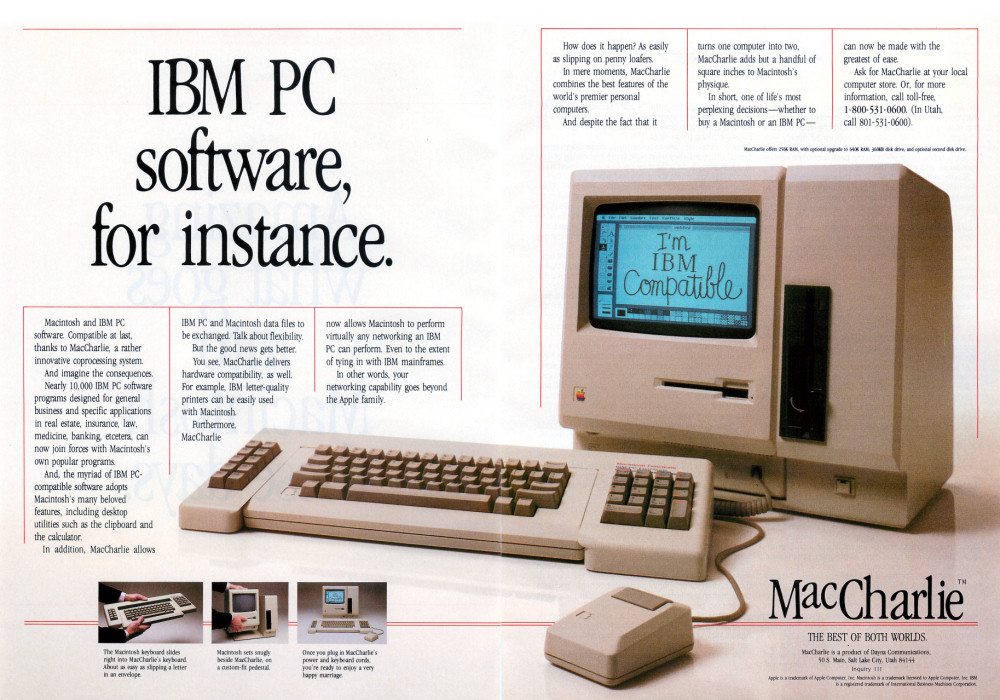
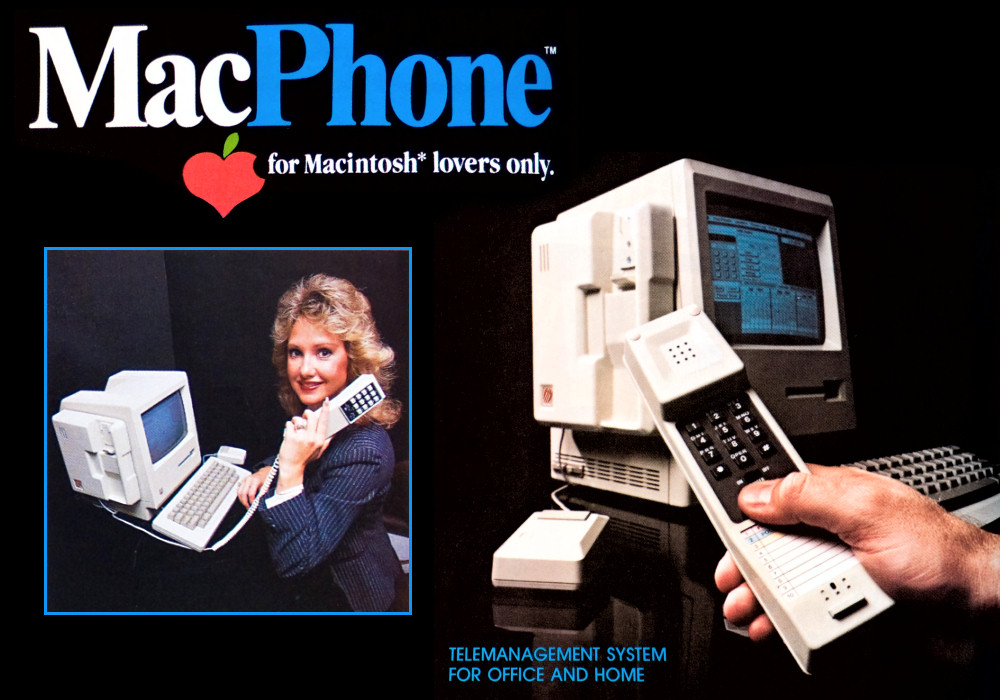
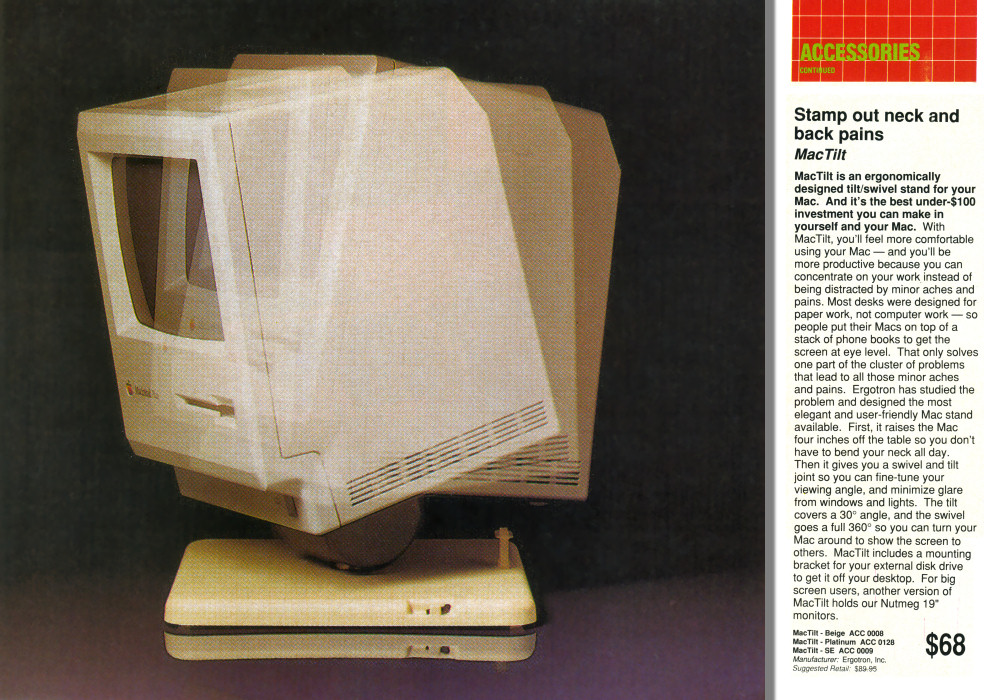
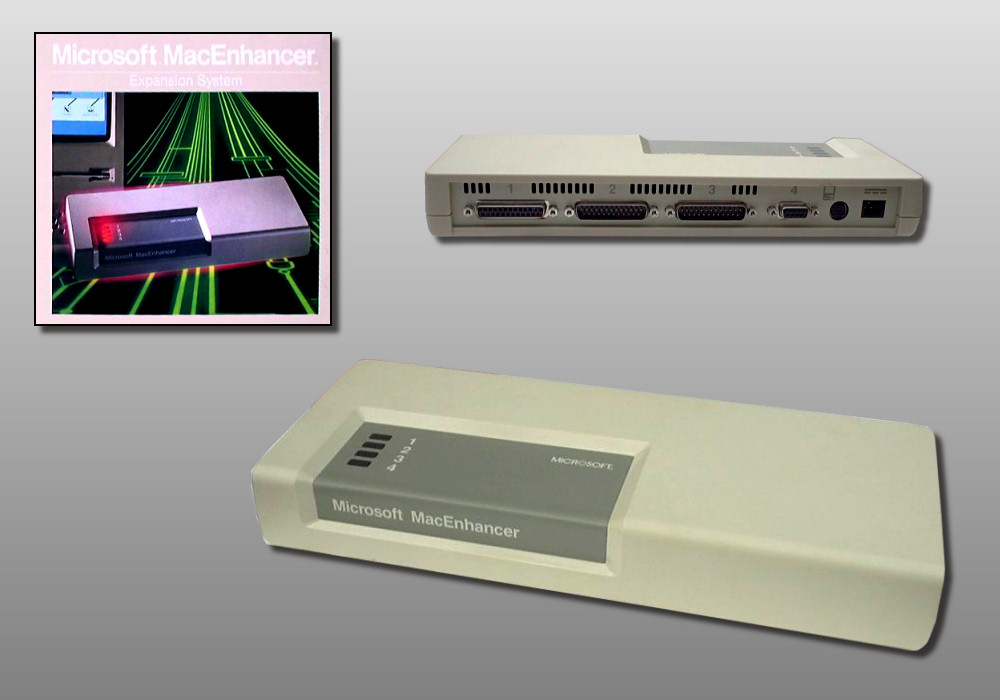
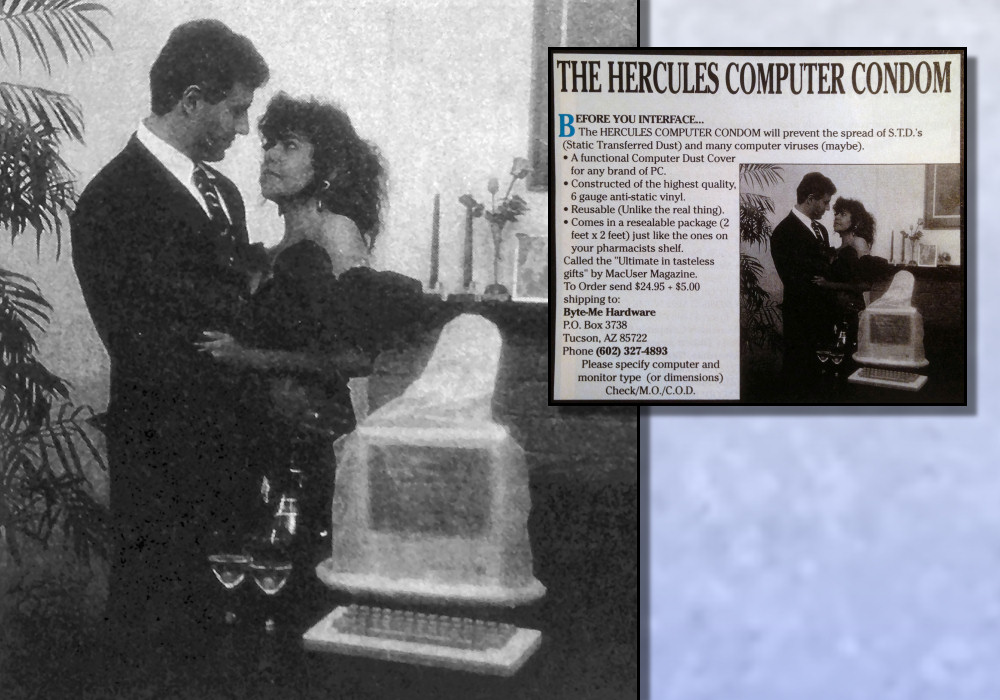
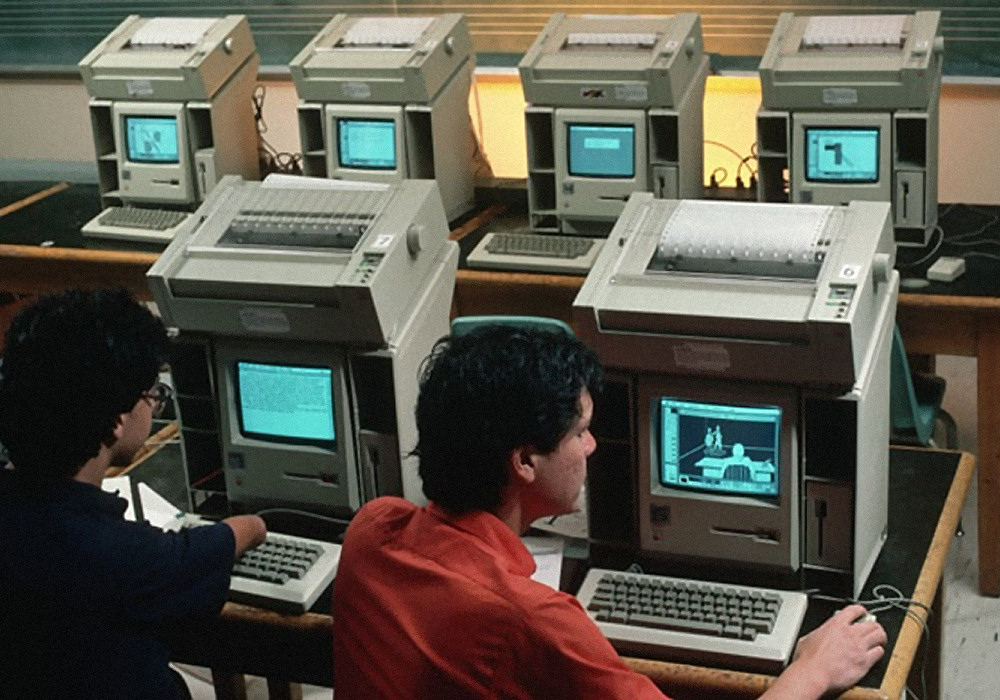


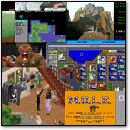
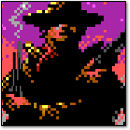
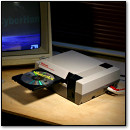

November 3rd, 2015 at 1:46 pm
ByteMe clearly saw the future: porn will consume the Internet and they wanted to protect your Mac the best way possible. Seriously, my school kept the Apple ][ computers under plastic covers when not in use, but they never had even an inch of excess plastic, much less a windsock.
November 3rd, 2015 at 4:41 pm
It’s interesting how we’ve come full circle.
Back then it seemed funny to expand a Mac by plugging in to the serial port or speaker port, but 30 years later we expand our machines just that way, by plugging into the USB or Thunderbolt port, or wirelessly over Bluetooth or Wi-Fi.
That last time I bought a computer with general-purpose slots was 2001, which were occupied by USB 2.0, Ethernet, and modem cards. Since then, unless I’m upgrading the RAM or perhaps the HD, I’m not opening the computer.
November 4th, 2015 at 10:11 am
I was thinking the same thing as I wrote this, Stan. It is funny how we’ve come back to external peripherals only in average consumer PCs (there are many exceptions, of course). I guess Steve Jobs got his way in the end after all.
By the way, do you guys like features like this? Should I do more of them in the future? My traffic stat software kinda stinks, so your feedback means everything.
November 4th, 2015 at 3:57 pm
I like how we’ve come back around to full screen apps just like how DOS was in the 80s. Look at your productivity apps on your smartphone and tablet, we’re back to full screen dos apps with better graphics as we jab at the screen instead of using the keyboard. 🙂
November 4th, 2015 at 6:26 pm
It’s a MacStation: https://books.google.com/books?id=py4EAAAAMBAJ&pg=PP2&lpg=PP2&f=false#v=onepage&q&f=false
November 4th, 2015 at 10:33 pm
Wonderful, Derek. Thanks! I don’t know what’s more amazing — the fact that such a product existed, or that it was produced by a company called MicroRain.
I will update the post in a bit.
November 5th, 2015 at 8:40 am
There’s also an interesting (I think) article later on in that MacStation link about unhappy Mac customers who bought the system within the first 100 days. They’re upset about the cost to upgrade RAM in the machine ($995 to go from 128K to 512K)!
November 11th, 2015 at 6:35 pm
Just letting you know I heard about this site on the “MacBreak Weekly” podcast, and had to come on over and check it out!
I remember the ads for most of these products in Macworld (and MacUser?), but – living in Australia – never saw any in person as it was hard enough to just buy a Mac!
I did play with an Address Book Desk Accessory that produced DTMF, and advised that one “hold the phone up to the speaker”. It worked 🙂
November 11th, 2015 at 8:25 pm
Thanks for coming over, Mike! It’s good to have you here with us.
November 13th, 2015 at 7:18 pm
Ugh, I’d forgotten how badly 1980s computer-industry advertising leaned on painfully stretched metaphors. The copy in that MacStation ad is cringeworthy. “And with the large front door, you can easily take Mac out for a walk.”? WE GET IT, IT’S A HOUSE FOR THE COMPUTER!
November 14th, 2015 at 9:28 am
Actually, all are good ideas for the time. Guess you had to be there to understand, that includes the MacPhone. The only reason why computers progressed to the modern day variants is because millions modified, enhanced and pushed the industry for what we needed.
Actually the Mac stuff is mild in comparison to what we were doing the the earlier computers that ran off of cp/m, dos, OS2 and just assembly language. (6402, 4004,8008,8080,z80, etc)
November 14th, 2015 at 1:28 pm
Never said they weren’t good ideas, Bill. Just strange ones. Believe me, I understand.
November 15th, 2015 at 6:06 pm
No ThunderScan 🙁
December 1st, 2015 at 10:07 am
Wasn’t there a doohicky you could put inside a classic mac to get video out? A sort of video daughterboard, and from that you could connect an external monitor? Or did I just imagine that.
December 1st, 2015 at 10:19 am
Bill,
There may have been something like that for the Mac 128K, 512K, and Plus that I don’t know about. It is certainly possible to create such a thing (and use it if you were willing to drill a hole in your Mac’s plastic case). But I do know that third party manufacturers created external video cards for the the Mac SE, which had one internal expansion slot, because I have a couple of them.
December 1st, 2015 at 12:46 pm
Benj said: “By the way, do you guys like features like this? Should I do more of them in the future?”
YES! I may not read stuff the day it comes out, but I do make it a point to come by and read every article you write regularly. Love computer history and nostalgia, keep it coming! Love it